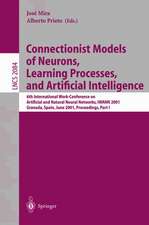Natural Object Recognition: Springer Series in Perception Engineering
Autor Thomas M. Straten Limba Engleză Paperback – 20 oct 2013
Preț: 327.44 lei
Preț vechi: 409.30 lei
-20% Nou
Puncte Express: 491
Preț estimativ în valută:
62.66€ • 65.58$ • 52.15£
62.66€ • 65.58$ • 52.15£
Carte tipărită la comandă
Livrare economică 31 martie-14 aprilie
Preluare comenzi: 021 569.72.76
Specificații
ISBN-13: 9781461277255
ISBN-10: 1461277256
Pagini: 196
Ilustrații: XVII, 173 p. 42 illus.
Dimensiuni: 155 x 235 x 10 mm
Greutate: 0.28 kg
Ediția:1992
Editura: Springer
Colecția Springer
Seria Springer Series in Perception Engineering
Locul publicării:New York, NY, United States
ISBN-10: 1461277256
Pagini: 196
Ilustrații: XVII, 173 p. 42 illus.
Dimensiuni: 155 x 235 x 10 mm
Greutate: 0.28 kg
Ediția:1992
Editura: Springer
Colecția Springer
Seria Springer Series in Perception Engineering
Locul publicării:New York, NY, United States
Public țintă
ResearchCuprins
1 Introduction.- 1.1 Motivation.- 1.2 Issues.- 1.3 Contribution.- 1.4 Example of results.- 2 Natural Object Recognition.- 2.1 Visual capabilities for autonomous robots.- 2.2 Related research.- 2.3 Limitations of current machine-vision technology.- 2.4 Key ideas.- 2.5 Experimental results.- 2.6 Conclusions.- 3 A Vision System for off-Road Navigation.- 3.1 Task scenario.- 3.2 Prior knowledge.- 3.3 The role of geometry.- 3.4 A vocabulary for recognition.- 3.5 Contextual information.- 4 Context-Based Vision.- 4.1 Conceptual Architecture.- 4.2 Implementation of Condor.- 4.3 Example of natural-object recognition.- 4.4 Automated knowledge acquisition.- 4.5 Complexity analysis.- 4.6 Discussion.- 4 Context-Based Vision.- 5.1 Evaluation scenario.- 5.2 Experimentation.- 5.3 Analysis of results.- 6 Conclusion.- 6.1 Contribution.- 6.2 Evaluation.- 6.3 Summary.- A The Core Knowledge Structure.- A.1 Introduction.- A.2 Core Knowledge Structure.- A.3 Logical Interpretation of the CKS Database.- A.3.1 Semantics.- A.3.2 Insertions.- A.3.3 Queries.- A.3.4 User-Defined Relations.- A.3.5 Discussion.- A.4 Slot Access.- A.5 Summary.- References.




























